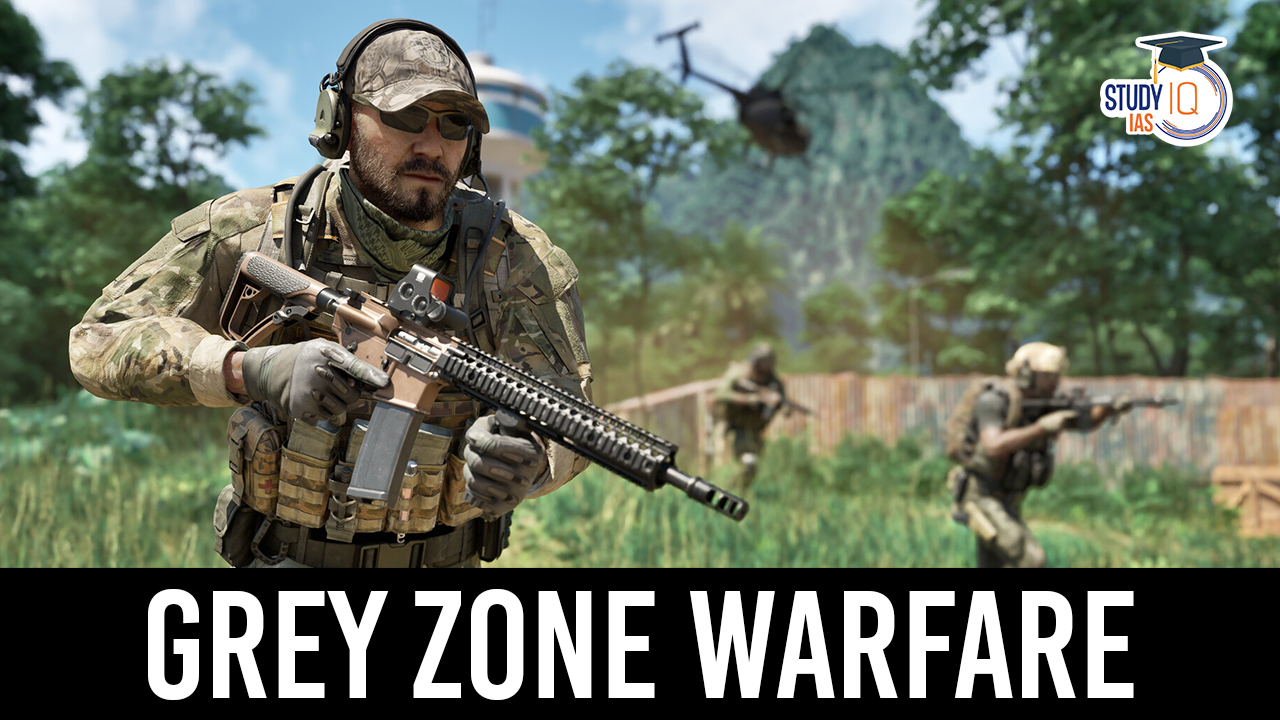Table of Contents
Context: Recent events on China’s borders (South China Sea, Line of Actual Control) to the concept of “grey-zone warfare,” suggesting China might be employing subtle, long-term strategies in disputed areas.
About Grey Zone Warfare and India’s Counter Measures
- Grey-zone warfare is a concept used to describe military and non-military actions that fall below the threshold of traditional warfare.
- Unlike conventional wars with open fighting and clear declarations of conflict, grey-zone activities operate in a grey area, often below the level that would trigger a full-blown military response.
- These actions manifest in the form of disinformation campaigns, proxy wars, economic pressure through sanctions or trade manipulation, technological espionage to steal intellectual property and support for insurgencies or non-state actors without openly declaring war.
| Note |
| The grey zone describes a set of activities that occur between peace (or cooperation) and war (or armed conflict). |
China’s Grey Zone Tactics Against India
- Cyber Operations: This includes hacking, data theft, denial of service attacks, and spreading disinformation to disrupt or influence India’s critical infrastructure and political systems.
- Example: The Indian government reported multiple cyber-attacks targeting its power transmission systems in 2022.
- Information Warfare: Utilising propaganda, spreading rumours, and manipulating social media to create societal divisions and undermine trust within India.
- Example: Intelligence services identified threatening messages to North Eastern Indian communities in Bengaluru as originating from China, part of a broader campaign to influence internal Indian matters.
- Support to Proxy Forces: Backing insurgent groups and non-state actors within India to sow discord and drain resources.
- Example: Chinese support to various insurgent movements in India’s northeast in the 80s and 90s, a strategy that has reportedly continued.
- Economic Coercion: Imposing trade restrictions and leveraging economic influence to pressure policy changes in India without resorting to open conflict.
- Example: China’s Belt and Road Initiative and leverage that could be used for political and strategic gains.
- Political Subversion: Covert operations to influence elections, manipulate political processes, and support groups that align with the aggressor’s interests.
- Example: China’s strategy includes funding research and influencing department heads at prestigious universities in the West, aiming to sway academic and policy discourse in fields of strategic interest to China.
- Legal and Diplomatic Manoeuvring: Exploiting legal loopholes, leveraging international institutions, and manipulating alliances to undermine India’s international standing.
- Example: China’s use of civilian fishing fleets to assert its presence in the South China Sea, circumventing international legal challenges.
- Military Intimidation: Show of military force near borders or in contested regions to threaten or imply potential military escalation.
- Example: The massing of People’s Liberation Army (PLA) troops at the contested Galwan region in Ladakh and the large-scale military exercises in the Taiwan Straits serve as intimidation tactics.
We’re now on WhatsApp. Click to Join
India’s Counter Measures To Grey-Zone Warfare
Border Defense Strengthening
Fortifying military readiness along contentious borders. Example: India has deployed advanced surveillance systems along its borders, including UAVs (Unmanned Aerial Vehicles) and high-tech surveillance cameras, to monitor and respond to any adversarial movements.
Strategic Partnerships
Engaging in defence collaborations with allies, such as the U.S.
Example:
India and the United States have significantly deepened their defence ties through agreements like the Logistics Exchange Memorandum of Agreement (LEMOA), the Communications Compatibility and Security Agreement (COMCASA), and the Basic Exchange and Cooperation Agreement (BECA). These agreements enhance logistical support, secure communication, and exchange of geospatial intelligence between the two militaries.
Joint Military Exercises
Participating in exercises to enhance operational coordination.
Examples:
- Exercise Malabar: Initially a bilateral naval exercise between India and the US, it now includes Japan and Australia, reflecting the strategic convergence of the Quad countries. Malabar focuses on enhancing interoperability and understanding between the navies.
- Indo-Russian Exercise Indra: This is a bi-annual military exercise between India and Russia, involving all three services (Army, Navy, Air Force), aimed at boosting military cooperation and interoperability
Naval Cooperation
Expanding naval engagements to secure maritime domains.
Examples:
- Mission SAGAR (Security and Growth for All in the Region): India launched this initiative to ensure maritime security and stability by assisting countries in the Indian Ocean Region (IOR). It includes humanitarian assistance, disaster relief, and enhancing maritime cooperation.
- Indian Ocean Naval Symposium (IONS): India plays a leading role in IONS, a forum for the navies of the Indian Ocean littoral states, aimed at increasing maritime cooperation and addressing regional security challenges.
Defence Technology Collaborations
Co-developing and co-producing defence technology and equipment with international partners.
Example:
Quad Alliance: Active participation in the Quad, alongside the U.S., Australia, and Japan, to address regional security challenges.
Information Sharing
Improving intelligence sharing with allies to better understand and respond to threats.
Example:
- Information Fusion Centre – Indian Ocean Region (IFC-IOR): India established the IFC-IOR to enhance maritime security and information sharing among countries in the Indian Ocean Region. It serves as a hub for sharing real-time maritime information and improving regional maritime domain awareness.
Modernising Armed Forces
Investing in new technology to modernise the military, making it capable of responding to a range of threats.
Example:
- Indigenous Defense Production: India is focusing on indigenously developing and producing defence equipment through initiatives like the “Make in India” program. Examples include the Tejas Light Combat Aircraft (LCA), the Advanced Towed Artillery Gun System (ATAGS), and the Akash surface-to-air missile system. These efforts aim to reduce dependency on foreign imports and strengthen the domestic defence industry.
| International Examples |
|


 Bharat Bandh 9 July 2025: Over 25 Crore ...
Bharat Bandh 9 July 2025: Over 25 Crore ...
 Sukhoi Su-57: Will India Choose Russia�...
Sukhoi Su-57: Will India Choose Russia�...
 World Bioproduct Day 2025: Date, Theme, ...
World Bioproduct Day 2025: Date, Theme, ...





















